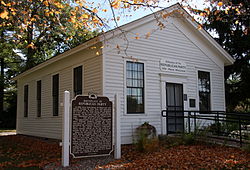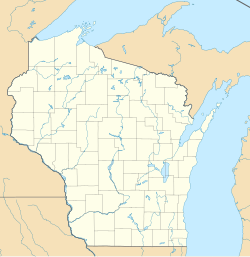Little White Schoolhouse
|
Little White Schoolhouse
|
|

The Little White Schoolhouse in 2013
|
|
| Location | 303 Blackburn Street, Ripon, Wisconsin |
|---|---|
| Coordinates | 43°50′38″N 88°50′11″W / 43.84389°N 88.83639°WCoordinates: 43°50′38″N 88°50′11″W / 43.84389°N 88.83639°W |
| Built | 1854 |
| NRHP Reference # | 73000079 |
| Significant dates | |
| Added to NRHP | August 14, 1973 |
| Designated NHL | May 30, 1974 |
The Republican Schoolhouse, also known as Little White Schoolhouse or Birthplace of the Republican Party, is a historic former schoolhouse at 305 Blackburn Street in Ripon, Wisconsin. Built in 1853, it was designated a National Historic Landmark for its role in the 1854 founding of the Republican Party. It is now a local history museum.
The structure was built in its original location in 1853 as a school building for the young town of Ripon, Wisconsin. It was championed as part of a wider education initiative by a New York transplant, Alvan Bovay. Bovay used his position in founding the school to further involve himself in politics, becoming a founder of the Republican Party, which formed during a meeting at the schoolhouse.
The building is a single-story wood frame structure, with a gabled roof and clapboarded exterior. It has modest Greek Revival styling, with a single entrance framed by pilasters and an entablature with cornice. There are sash windows on either side of the entrance.
In 1854, opposition grew to the proposed Kansas-Nebraska Bill. The bill was championed by the dominant Democratic Party, and the opposition was split among several smaller parties, including the Whig Party, the Free Soil Party, and some internal Democratic Party splintering. In Ripon, Bovay, who had gotten the schoolhouse built, lead the opposition, and canvassed support among opposition members of all the local parties. He called a meeting on March 20. The Whig and Free Soil parties dissolved themselves in favor of forming a new, united party to be called "Republican," with some Democrats also defecting from their local party branch to join the new party. With publicity from the New York Tribune, word of the party spread, other local chapters and state-level parties started forming by July or earlier, and a national party was formed by 1856.
The town quickly outgrew the small building, and built a larger brick building to replace it. The old building was sold to Wisconsin governor George Peck, for use as a home. By the early twentieth century, it had fallen into disuse, and was in danger of being demolished. Due to its historical significance, effort was put into saving the building.
...
Wikipedia


